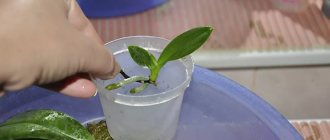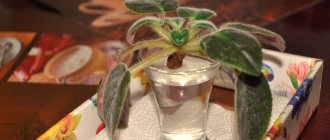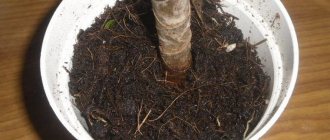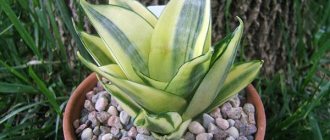Violet or Saintpaulia is an elegant and delicate flower that requires special care and attention. One of the important conditions for growing a healthy flower is replanting.
To preserve its decorative qualities and ensure its full development, the plant should be replanted in a timely and correct manner. Let's take a step-by-step look at how to transplant Saintpaulia yourself and without mistakes .
When should a violet be replanted?
Several factors indicate the need to replant the plant:
- A white coating appears on the ground. This indicates that the soil has poor air permeability. Also, the presence of a white coating indicates oversaturation of the soil with minerals. As a result, the roots begin to rot and the plant loses its attractiveness.
- The root ball grows too much and is visible on the surface of the soil, under the leaves. This interferes with the growth and development of the flower.
- The soil is depleted , has become dense, and the plant does not receive any nutrition.
- Violet leaves turn brown ; fertilizing does not help.
- The plant has grown and part of the bare stem has appeared. The transplanted flower will be more magnificent and beautiful.
- New “babies” have appeared that need to be separated from the mother’s outlet.
The appearance of any of these signs indicates that it is time to change the Saintpaulia container.
In this video you will be told about the importance of replanting violets with changing soil.
Is it possible to carry out the procedure with a flowering plant?
If flowering buds appear on the violet, then replanting is undesirable . The presence of flowering buds just means that the plant is doing well. It can be replanted after it has flowered.
However, there are emergency cases when it is necessary to replant a flowering plant in order to save it. In this case, for replanting it will be possible to use the transshipment method, having previously trimmed all the buds.
We recommend watching a video about whether it is possible to replant a blooming violet:
Transfer time
For violets to take root better, spring is . At this time of year, the plant has enough natural light, and the temperature for transplantation is optimal. As a result, Saintpaulia will tolerate a change of “place of residence” well.
September and October are also recommended for replanting capricious violets into new pots. In the summer heat, it is undesirable to touch the plant . At high temperatures, the transplant will cause him unnecessary stress. The same applies to the winter period. Due to a lack of sun and uncomfortable temperatures, the plant may not take root and die.
Optimal conditions for the transplantation procedure are ten-hour daylight hours and a temperature of +18 degrees . If you still need to replant Saintpaulia in winter, you need to install special lamps for additional lighting and ensure the required level of humidity in the room.
Beginning flower growers often ask whether it is possible to replant a blooming violet. Transplanting Saintpaulia during flowering is resorted to only in emergency cases .
If a plant is exposed to a disease or is attacked by pests, it must be replanted immediately, regardless of flowering or time of year. The violet is also replanted if it is too flooded , which can cause the roots to rot.
Important! After transplantation, flowers or buds should be removed so that the plant directs all its energy to rooting and not to flowering.
Under normal conditions, the flower is not touched during the budding period. Flowering indicates the plant is in good health. Since it blooms, it has enough nutrients. Therefore, replanting can be delayed until flowering is complete.
Some gardeners rely on the lunar calendar for transplanting violets. It indicates favorable periods for planting, down to the day.
Features of the process and subsequent care
There are a number of rules according to which it is necessary to replant violets:
- The container must be thoroughly rinsed with water before replanting, regardless of whether it has been used before or not. In this case, the dishes must be correctly selected. The best material for cookware is plastic.
- When replanting Saintpaulia correctly, its lower leaves should be in contact with the ground.
- You should not water the violet immediately after planting. This can lead to rotting of the root system. To maintain soil moisture, you need to cover it with a transparent plastic bag.
- It is advisable not to neglect plant rejuvenation procedures during the transplantation process. In order for the violet to take root quickly and painlessly, it is also necessary to properly care for it during the first time after transplantation.
To do this you need:- To ensure normal growth, it is necessary to maintain moderate humidity (approximately 50%) and a temperature above 21 degrees Celsius in the room in which the transplanted violet is located.
Daylight hours should be at least 10 hours.
- It is necessary to protect the flower from sudden changes in temperature and drafts.
- Watering should be done carefully and in moderation. Do not spray leaves.
- After 2-3 weeks, you can begin to introduce fertilizing, first in small doses, and then gradually increase to normal.
You can read about the features of caring for this beauty in our article.
Transplanting violets after purchase
After purchasing a violet, you need to carefully inspect it, remove dried buds, flower stalks and leaves. Store-bought flower pots usually contain a peat mixture that contains no nutrients. Therefore, after purchase, the plant should be replanted as soon as possible .
To do this, prepare a new substrate by mixing high-moor peat with vermiculite. This mixture will be moderately sour and loose. If you wish, you can purchase ready-made soil for violets .
After transplantation, the plant is covered with film to obtain a greenhouse effect . After 7 – 10 days, the film can be removed.
If the flower was purchased not in a store, but from familiar flower growers, you don’t have to rush to change the pot. In this case, the young plant is not immediately replanted, giving it time to develop the root system.
How to plant a violet in a pot
The need to transplant an adult violet for an experienced gardener is easily noticeable when looking at the plant and the pot with soil.
So, a transplant is required if:
- a whitish layer has formed on the surface of the soil: this is probably due to the excessive application of mineral fertilizers;
- the lower leaves have dried out and the base of the stem has become bare: this may be due to depletion of the soil;
- the old roots have grown so much that the soil is not even visible because of them;
- due to errors in care, the plant began to hurt;
- it is necessary to separate the mother plant and the resulting young shoots.
The latter is associated with the propagation of the flower, which is also carried out by other simple methods, after which the young plants require planting in pots with a nutrient mixture. For one reason or another, Saintpaulias are replanted annually. This is not recommended in summer because the air temperature is too high and in winter when there is not enough natural light.
The optimal time for planting is May. The autumn option (November) is also possible, but it will require additional lighting.
How often to replant
In flowering perennials, the root system develops quickly . The plant quickly draws all the nutrients from the soil, and it becomes depleted. The roots begin to peek out of the drainage holes or above the ground. The violet needs to be replanted at least once every 7–8 months.
Timely transplantation of Saintpaulia into a new pot will help prevent diseases , and the violet itself will delight with beautiful flowering.
What to do if it’s time to plant a blooming violet?
It is not recommended to replant blooming violets . You need to wait for the end of flowering.
But it happens that it is high time to plant violets in rosettes, but the mother bush continues to form buds. Then the violet is seated as it should be. And on an adult Saintpaulia, all flowers and buds are torn off so that all efforts are spent on restoring the root system.
How to choose a pot
Shallow pots are chosen for relocating Saintpaulias , since the roots of these flowers develop from the bottom up. A height of 10 cm and a diameter of 9 cm will be sufficient. If the plant is planted in a larger pot, it will intensively develop roots and entangle the earthen ball, and there will be no strength left for flowering.
A pot made of clay or plastic is suitable for violets . A clay pot provides good air permeability and maintains soil moisture at the roots. In such a pot, the plant is less likely to get sick and be attacked by pests. The downside of these pots is that they are heavy and not cheap.
A plastic flower pot is lightweight and easy to care for. Its disadvantage is poor air circulation. To fix this, holes are made with a nail in the bottom and side walls.
In this video they will show and tell you what pots and soil to plant violets in.
Requirements for pots
How to transplant a monstera at home step by step
Before planting a violet, you first need to choose the right container. These flowers have a unique root system that grows not in depth, but in breadth.
Selection of pot
Pots for violets are selected in accordance with this factor. The remaining criteria are not so important, and the design is determined by individual preferences, in accordance with the features of the interior.
Pot capacity
Inexperienced gardeners often make mistakes and plant violet sprouts in huge flowerpots.
Which pot according to parameters would be ideal for violets:
- For an adult sprout, a container with a height and diameter of 90 mm is ideal.
- The size for medium-sized bushes is 7 cm in height and 7 cm in diameter.
- Young seedlings should be placed in special pots for young plants. Depth and diameter parameters: 5x5 cm.
It is strictly forbidden to choose large containers - the plant will die. The pot should accommodate the root system end to end.
Pot shape
The pot should resemble a deep plate, since the roots are located only on top of the substrate, and the rest of it deteriorates over time.
Violet pot
Therefore, the less land left at the bottom of the container, the better. A long rectangular or square version of the container can be used. The main thing is that the size of the form is not too large.
Choosing flowerpots
Pots for violets can be selected in accordance with the design decisions of the room. It is desirable that the decorative container is suitable in depth and size - the pot should not fit closely into the flowerpot. The material and color are also individual.
What soil to plant violets in
To independently prepare soil that is best suited for violets , you will need the following components in equal parts:
- two parts of leaf soil;
- part of coniferous soil;
- part of the peat;
- part of the turf land;
- some river sand;
- a handful of charcoal.
Advice! For better results, vermicompost can be added to the soil 2 weeks before transplanting.
The prepared substrate must be disinfected. To do this, it is steamed in the oven or doused with boiling water. After the soil has cooled, you can begin replanting the Saintpaulias.
How to carry out the procedure correctly?
Soil preparation
It is recommended to purchase soil in a store, otherwise there is a risk of infecting the plant with diseases . If it is not possible to take it in the store, but it is necessary to disarm the soil: it is necessary to steam it and fertilize it with a solution of potassium permanganate.
Soil composition:
- River sand – ½ volume.
- Coniferous soil – 1 volume.
- Crushed moss – 1 volume.
- Leaf soil - 1 volume.
- Turf soil - 2 volumes.
Tip : Expanded clay, brick chips, pottery shards or moss can be used as drainage. For young plants (up to 6 months), drainage should occupy 1/3 of the pot, for adults - ¼ of the pot.
Fertilizers
Usually, when replanting, it is not recommended to add fertilizers, since if the soil is prepared correctly, it already contains all the necessary nutrients . But when preparing the soil, you can slightly “revive” it by adding microbiological fertilizer “Baikal EM-1” 14 days before transplanting. “Baikal EM-1” is mixed in a ratio of 1 to 100.
You can also add Fitosporin-M to the new soil when replanting. First, you will need to prepare a liquid concentrate from it, according to the instructions, and then dilute the resulting concentrate in a proportion of 1 ml per 2 liters of water, and moisten the soil with it before replanting.
Just before transplanting, you can add a little vermicompost, charcoal or coconut substrate.
Dishes
You can choose a plastic or ceramic pot or container as a container for replanting. A clay pot contains pores, which causes the earthen ball to dry out faster .
The dishes should be wide, the diameter of the dishes should be 1.5-2 times greater than its height. In this case, the diameter should be 2-3 times smaller than the plant itself. There must be holes for drainage.
We recommend watching a video about choosing a pot for violets:
Preparing the plant
Before transplanting a violet, it should be prepared for the procedure . The soil in the pot is moistened so as not to damage the roots of the plant. There is no need to fill the pot with water until dirt forms; the substrate should remain loose.
The violet is carefully removed from the old flowerpot, trying not to stain the leaves. Some of the root shoots are cut off and large leaves are removed . These manipulations activate the rejuvenation of the flower.
Ways to plant violets
You can plant indoor violets using:
- seeds;
- roots;
- leaves;
- shoots, peduncles.
Using material from an adult plant allows you to save money on purchasing seeds and preserve damaged bushes of rare varieties.
Root planting
To propagate violets by a shoot with a root system and leaves, it is necessary to prepare planting material. Requires cuttings with roots and 2-4 leaves; there must be a developing point of growth.
Before properly planting a violet root, it is necessary to ensure a suitable microclimate in the room. Plants develop with at least 12 hours of daylight. In winter, it is necessary to organize illumination using phytolamps or fluorescent lamps. It is important to maintain a temperature of +24…+27°C.
For options with unbranched roots, growing is required; The shoot is placed in a container with moss or perlite and covered with a cloth. The formed seedling is moved into the soil. A plant grown from a leaf at home must be kept in a greenhouse for about 2 weeks, regularly ventilated. After the bush reaches 1.5-2 pot diameters, it is transplanted into a stationary container.
Planting from a leaf with roots
To propagate violets from leaves with a root system, it is necessary to prepare a cutting from an adult plant. Planting material is selected from 2-3 tiers of well-formed young rosettes. A part of the leaf up to 4-5 cm is cut at an acute angle and disinfected with copper sulfate, saline or soap solution.
The vessel for growing violets from leaves must be clean and sterilized. Glasses or flasks made of darkened glass are recommended.
In a container with water (settled or boiled), roots are germinated. Part of the leaf should be in water at a depth of 1.5-2 cm. The material grown for seedlings is located in a place with average illumination.
The recommended water temperature for root development should be maintained at +25°C. In cool water the sheets will rot.
If the planting material is damaged, it is necessary to cut off parts of the leaf by 1.5 cm. It is allowed to trim the material 2-3 times before the roots form. It is necessary to change the water after the procedure.
To speed up root growth, you can add stimulating additives to the container with the leaf. The material is placed in an aqueous solution until small roots appear for 2-4 weeks.
For a plant to take root, a compact container is required. Planting material is placed in the soil at an average depth. The lateral roots should be buried 2 cm. Watering for rooting violets is carried out with warm water (+35°C).
For 7-14 days, seedlings must be placed under covering material or glass to create a greenhouse effect. It is important to perform daily ventilation. After rooting, flower care is carried out in the standard manner. Transplantation into a large container is carried out after increasing the volume of the leaves several times.
Planting with leaves without roots
It is possible to plant violets with leaves without roots. The procedure is performed with a small volume of planting raw materials and for rare species of Saintpaulia. A cutting and part of a leaf with at least 1 vein are required. The material is dried and sprinkled with crushed coal.
For planting, part of the leaf is placed tightly into the ground in compact pots or plastic glasses with openings for water drainage. It is necessary to fill the container with drainage by 1/3; the remaining volume is filled with soil.
It is not recommended to place planting material deep, because the sprouts will not be able to rise to the surface. The soil next to the cutting is compacted, watered, and the pot is covered with polyethylene or glass to preserve the microclimate and maintain the required level of humidity. After the shoots appear, the young plants are distributed into permanent pots.
The best option is to plant part of the plant in sphagnum, which has moisture-retaining and disinfecting properties. Growing violets from part of a leaf allows you to form more shoots than with other methods.
Planting with a shoot
Breeding Saintpaulias by stepsons or peduncles is carried out to maximize the preservation of the characteristics of the variety (shade intensity, size, shape of leaves and flowers).
It is necessary to separate the side rosettes (stepchildren) formed around the main stem of the bush. The material is placed in a small container with soil and watered regularly. After growth, the voluminous bush is transplanted into a pot of appropriate size.
To propagate Saintpaulia with peduncles, several hybrid varieties are used (chimera violets, etc.). It is necessary to separate the peduncle that has faded or recently opened. Closed buds are not used for propagating Saintpaulia.
Disinfected with a knife or blade, it is necessary to cut off the peduncle and stipules. The material is placed in sphagnum; A greenhouse net is created over the plant. After the appearance of a new rosette and rooting, the plant is moved to a stationary container. It is recommended to immediately add superphosphate fertilizer to develop the bush and organize abundant flowering.
Three methods of transplantation
Depending on the purpose or reason for the procedure, there are three methods , each of which has its own advantages.
Complete substrate replacement
This type of plant replanting is resorted to when the violet stops growing and developing, does not bloom and looks unhealthy . This is a signal that the plant has used all the microelements and the depleted soil can no longer nourish it.
Complete removal of old soil involves cleansing the root system . It is inspected and dried, rotten and damaged parts are removed. As a result, the root part is significantly reduced, and the plant can be planted in a pot of smaller diameter.
Expanded clay is scattered on the bottom as the first layer . Then a small amount of soil is poured on which the violet is laid out, carefully straightening its roots. Next, fill the remaining soil until it comes into contact with the lower leaves. The soil is mulched with vermiculite.
To check whether the soil is well compacted, shake the pot with the plant. compact the soil again .
To maintain soil moisture for the first day, the plant can be covered with plastic film .
This video explains in detail how to properly transplant a violet.
Partial soil replacement
Partial replacement is carried out every time a healthy plant needs to increase the pot . To do this, part of the soil is removed, but the earthen ball around the roots is not touched.
The violet is removed from an old pot in which the soil has been previously moistened. Having transplanted it into a large pot, add the prepared nutrient mixture and tamp it down with a teaspoon.
Transshipment
Transshipment is used when it is necessary to urgently relocate a flowering plant or replace a container that has become cramped with a more spacious one.
The violet is carefully removed from the container along with the earthen lump. Drainage and part of the prepared soil are poured into the new pot. Then the used container is inserted, and the space around it is filled with soil. After this, the unnecessary pot is removed and a flower is placed in its place. All that remains is to carefully level and compact the earth.
Obtaining planting material
Before transplanting a flower, you need to prepare it . The soil will need to be moistened so that the flower and the lump can be easily removed from the pot. The roots are cleared of soil and damaged ones are cut out. If the roots are very overgrown, approximately 2/3 of them can be removed without harming the plant.
If a flower needs to be rejuvenated, then for this you will have to remove not only part of the roots, but also part of the leaves. When rejuvenating, transplant the plants into a smaller pot. You can also rejuvenate the plant by cutting off the roots along with the stem and dried leaves. In this case, a sharp, disinfected knife is used during circumcision. The remaining upper part is placed in a glass of water, and, after waiting for a good root system to form, it is transplanted into a pot.
Growing from a leaf
You can obtain planting material using leaf propagation:
To do this, it will be necessary to select healthy, elastic leaves located in the second or third row from the rosette.- These leaves are cut with a sharp, disinfected knife, dried for 15 minutes and sprinkled with charcoal.
- Then cool boiled water is poured into a dark plastic cup and an activated carbon tablet is dissolved in it.
- Next, the stem of the leaf is immersed there no more than 1 cm.
- The resulting planting material can be replanted after the cut roots become longer than 1 cm.
We recommend watching a video about growing violets from leaves:
You will find all the detailed information about growing violets in a separate article.
How to seat children
It is important to know how to plant young shoots so that they take root. Young rosettes are distributed into pots with a diameter of 6 cm after two pairs of leaves have appeared on them. To prepare the soil, use vermiculite, peat and chopped sphagnum.
The babies are separated from the mother's rosette along with a large leaf. Then they are seated in separate containers at a shallow depth. The soil is moistened , and before rooting, containers with young plants are placed under a lamp.
This video will tell you when it’s time to separate violet babies from the mother leaf and how to do it.
How to prepare soil for transplanting violets yourself
After determining how to properly plant a violet, it is worth preparing the substrate. If you wish, you can do this yourself. You just need to know what soil to use.
Fertile soil for violets - make the composition with your own hands:
- turf soil;
- humus from spruce needles and leaves;
- perlite;
- river sand;
- peat.
Soil preparation
To avoid the appearance of insects in a homemade substrate, you need to carefully sift all the components.
Care after transplant
To ensure that transplanted plants do not experience stress and recover faster, they need to be helped with proper care . It is necessary to maintain optimal temperature, soil moisture and lighting.
After transplanting the perennial, adhere to the following rules for 2 weeks:
- cover the plant with film ; when condensation forms, remove it for a couple of minutes for ventilation;
- the flower pot is left in a warm place (24 degrees) ;
- Saintpaulias provide sufficient lighting, but protect from direct sunlight .
Composition of the nutrient substrate
In flower shops you can purchase a special soil mixture for violets. It includes the necessary minerals and biohumates. Sometimes the substrate is prepared independently using the following ingredients:
- leaf soil;
- peat;
- coniferous soil;
- turf land;
- river sand.
The required proportions are 2:1:1:1:1. To improve drainage, it is better to add a handful of crushed or fine charcoal.
The soil must be treated to remove fungus, bacteria and pest larvae. The best option is calcination in the oven for 20-30 minutes at a temperature of +200 °C. If it is inconvenient to use the oven, it is necessary to treat the soil with boiling water.
Possible errors during transplantation
Knowing how to replant Saintpaulia correctly, you can avoid mistakes and prevent the death of the plant . The most common mistakes made when performing this procedure are:
- The planting depth is chosen incorrectly . Too deep and the roots will rot; too high and the rosette will sway.
- Choose a pot with a large diameter. The plant will not be able to bloom; it will try with all its might to develop the root system.
- The substrate is not prepared correctly . It should not be too dense and oversaturated with nutrients.
- They use soil from greenhouses and greenhouses , which contains pest larvae and fungal spores.
- When watering, water is not poured under the root, but poured into the center of the outlet . This leads to the death of the plant.
This video talks about mistakes when rooting indoor violet cuttings.
Transplanting violets at home requires preparation and
adherence to certain rules .
However, the reward for good care will be a healthy plant that pleases the eye with lush flowering. Read more about when to repot indoor plants here.
Possible problems
Rotting flower . After transplanting violets, some gardeners notice that the plant has begun an active process of rotting. This may be due to:- The presence of parasites in the soil, poor soil quality.
Damage to the plant during transplantation.
- Excessively abundant watering.
- Leaves turn yellow and dry out. It would seem that after transplantation, the violet in the new soil should become more beautiful and healthier, but light or yellow spots begin to appear on its leaves, or the leaves begin to dry out. The reasons may be:
- Incorrectly selected soil.
Inappropriate location of the pot.
- Failure to comply with the watering regime after transplantation.
- Doesn't bloom. Reasons for this problem:
- When replanting, the container chosen was too large.
- The soil is not selected correctly.
- The transplant was carried out in winter.
- Damage to the measles system.
In this case, treatment must be urgent and drastic: all damaged parts must be removed and the violet rooted using a healthy leaf.
In the first case, transplanting into the “correct” soil will help, in the second and third – following the rules of caring for the plant.
Prompt elimination of the causes will lead to the long-awaited formation of buds.
Violet is one of the most charming and popular house flowers. Thanks to breeders, the list of new species of this beauty is constantly expanding. Most of them can be grown quite easily by novice gardeners. But first, you should familiarize yourself with all the rules of care, reproduction, as well as diseases and pests that can prevent you from growing a healthy and beautiful plant.
How to plant young plants
The rosettes obtained from a rooted leaf are transplanted after 2 - 3 months into separate cups, where they will grow for a long time until they bloom and the pot becomes small.
The main thing in keeping such babies will be the creation of favorable conditions for development - good lighting, temperature conditions and moderate soil moisture.
How to grow an adult plant from a baby?
You can raise children yourself or trust store specialists:
- If you grow the babies yourself, then when they appear on the leaf, do not rush to separate them. This is done when the rosette reaches a size of 4-5 cm and has a pair of leaves;
- If you bought a baby, then do not rush to transplant it into your pot. Give her time to get used to the ground. And after 2 weeks, replant.
Plants in the stage between baby and adult are called “starters”. At this stage, the plant is transplanted into fresh soil. At the same time, all the lower, small leaves are torn off, this contributes to the formation of a beautiful and regular rosette.
Stages of violet development.
There are several important points on how to grow a beautiful rosette:
- if the “sterter” is constantly flooded, an irregular rosette will form, the leaves will bend, and the middle will become denser;
- At the stage of rosette formation, lighting plays a very important role. In order for it to be of the correct shape, the pot with the plant is periodically turned towards the light;
- the first buds and stepsons that appear are removed, the violet is not yet ready for full flowering;
- with the further growth of Saintpaulia, temperature plays a role in the formation of a correct rosette.
Within 7-9 months after the baby has separated, you will have a fully formed plant.
Why don't homemade violets bloom?
There is an opinion among amateur flower growers that Saintpaulias, better known as violets, are not picky in their care and, when planting them at home, they count on the year-round availability of beautiful flowers of different shades and a pleasant aroma inherent in many varieties of this species.
Disappointment from the fact that the plant quickly develops leaves, but no flowers, occurs quite often, because caring for a violet involves more than just watering.
The reasons for the lack of flowering for a long time may be associated with the following factors:
Lighting: its duration and intensity directly affects the formation of the violet peduncle. Saintpaulia loves light and its lack causes improper development of the plant, in which flowering may not occur at all. When choosing a place for a young flower, make sure that it receives good sunlight, but so that it does not burn the leaves. Northern and western window sills are suitable. In the south, especially in the summer, greenery will suffer from excess direct rays. Remember! Regardless of where the plant is located in the house, it needs 10-12 hours of daylight, otherwise it suffers from lack of sun. To achieve this goal, a combination of natural and artificial lighting, if necessary, is well suited. A signal that Saintpaulia does not have enough light will be the stretching of the leaves - they will be drawn to the light source if the place for the flower was chosen incorrectly. Humidity and watering can also affect the natural development of flowers. Saintpaulia does not tolerate drought or excessive watering. In both cases, the plant loses its beautiful appearance and begins to hurt. Abundant watering leads to rotting of the root system, and its lack leads to drying out of the ground part of the flower. It is optimal to use a tray with water for watering, this way the violet will absorb the moisture it needs. The remainder needs to be drained
With the top watering method, you should carefully apply water under the roots, without touching the leaves and rosettes, as water can harm them. Important! Another important factor when adding water is its temperature: in no case should you use cold water directly from the tap . The flower prefers liquid at room temperature, which has settled well. In their natural habitat, violets grow near bodies of water, and they require a constant level of humidity for full growth
A good solution in the house would be a container of water standing next to the flower. You should not spray Saintpaulia with cold water, especially in winter; spraying is permissible only in the hot season, but only with warm water and not very abundantly. Incorrect room temperature can also lead to a lack of flowers, in particular, if it is too high, the optimal option for a plant year-round is 16-20 degrees. In order for Saintpaulia to delight with flowers, it must be fed frequently; in the absence of the required amount of fertilizer, the soil quickly loses nutrients and the plant has nothing to draw strength from to bloom. For violets, the composition of the substrate in which it lives is important. If its composition is incorrect, it will not only not bloom, but will also not be able to develop normally. The easiest way is to buy a substrate for Saintpaulia in a store, but you can prepare it yourself. You should not take hard soil; you must add baking powder and fertilizer to the mixture. Since the flower has a delicate root system, it needs a substrate that is light in consistency. The size of the flowerpot in which Saintpaulia is planted also affects flowering. You should not replant it in large and spacious pots, otherwise you will end up with an ornamental deciduous plant without flowers. Diseases and pests can also affect flowering, since if they are present, all the forces of Saintpaulia go to fight them. If traces of insect life appear on the plant, it should be treated immediately, otherwise it will quickly die. The same applies to signs of various diseases, which will be expressed in a deterioration in the appearance of the violet.
In addition to these reasons for the lack of flowering in the type of indoor greenery in question, you should also know the characteristics of the variety grown at home. Each variety has a certain flowering period and for some it is not long.











